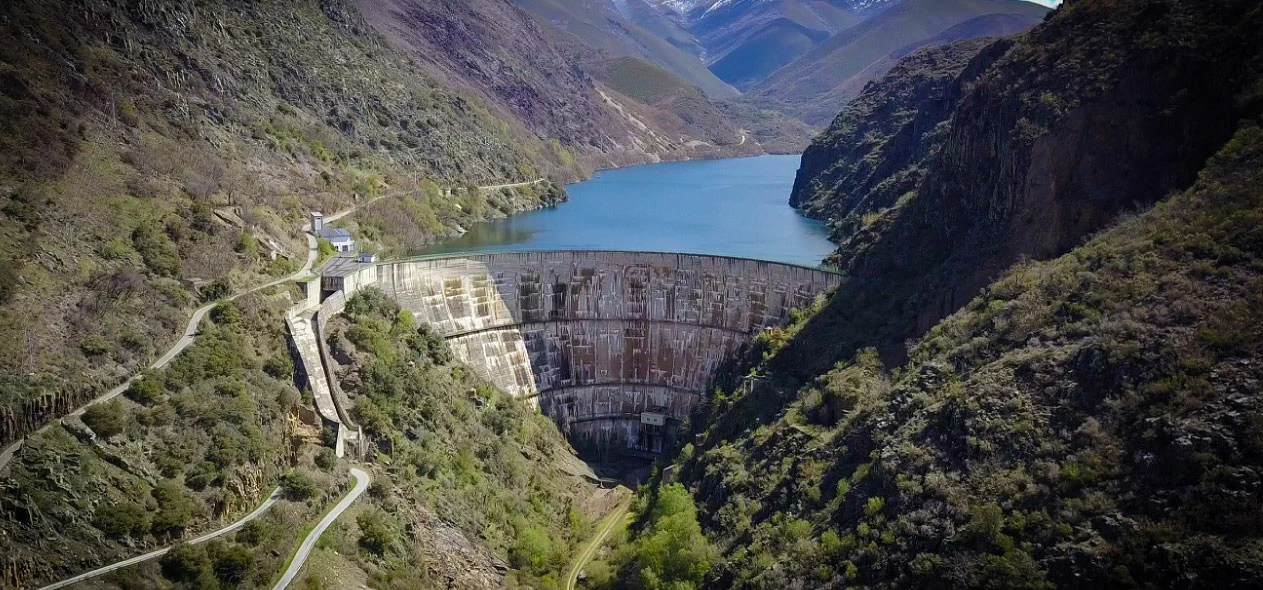Need advice?
Send us your details and we will contact you
Contact usSpain has vast experience in the development of technical safety standards for dams and reservoirs, which has evolved in parallel with technological progress and the growing needs of society.
This evolution has been driven, in part, by accidental or catastrophic events that highlighted the need for adequate regulations to protect people, the environment and material goods.

The Spanish Government regulates these infrastructures through Royal Decree 264/2021, which establishes the technical and safety requirements for dams and reservoirs. This decree defines the obligations and responsibilities of the holder of the weight, as well as the control procedures and the functions of the Public Administration in all phases of the life cycle: from the design and construction of dams, to their operation, commissioning and, eventually, to their dismantling.
With more than 1,300 dams in operation, Spain is one of the European countries with the highest dam density, reaching 2.4 dams per 1,000 km² and 30 dams per million inhabitants. Almost half of these infrastructures are more than 50 years old, underscoring the importance of implementing rigorous surveillance, maintenance and conservation systems to ensure that they continue to operate safely and efficiently.
At SOCOTEC we offer specialized services in auscultation and inspection of dams and reservoirs with which we guarantee the optimization of the surveillance, maintenance and conservation systems of dams and reservoirs under the highest standards of safety and efficiency. Our expertise, coupled with state-of-the-art technologies, allows us to detect and correct potential problems before they become serious risks, thus ensuring the longevity and sustainability of each project. By relying on SOCOTEC, you will be able to enjoy not only excellent technical service, but also a commitment to safety, innovation and respect for the environment.
Royal Decree 264/2021, of 13 April, constitutes the legal framework governing the technical safety standards applicable to dams and reservoirs in Spain. This public domain regulation seeks to guarantee the structural and operational integrity of these infrastructures, taking into account their potential impact on the surrounding areas. Below, we set out the most relevant aspects of this regulation.
The safety of dams and reservoirs is a crucial aspect in the management of water resources and in the prevention of risks associated with structural failures. Royal Decree 264/2021 expands and updates the previous technical provisions, improving surveillance protocols and preventive measures.
The regulations are aimed at both dam owners and operators and the competent authorities, who must comply with rigorous safety standards to preserve their efficiency and longevity. Although the decree covers dams of different sizes and capacities, it places special emphasis on those with a greater potential risk to the population and the environment.


The Royal Decree establishes a classification of dams and reservoirs based on their height and storage capacity, as well as on the risk that their rupture or malfunction could represent. This dam classification is essential to define specific monitoring and control requirements. The dams are grouped into three categories according to their height (greater than 15 meters or between 10 and 15 meters) and the volume of the reservoir:
Category A and B dams must have emergency plans, while category C dams must review their classification every five years, considering the hazardous conditions in downstream areas.
The Royal Decree establishes a classification of dams and reservoirs based on their height and storage capacity, as well as on the risk that their rupture or malfunction could represent. This dam classification is essential to define specific monitoring and control requirements. The dams are grouped into three categories according to their height (greater than 15 meters or between 10 and 15 meters) and the volume of the reservoir:
Category A and B dams must have emergency plans, while category C dams must review their classification every five years, considering the hazardous conditions in downstream areas.
One of the key points of the technical safety standards for dams and reservoirs is the implementation of customized surveillance and control programs for each infrastructure. These programs must be designed by qualified technicians and must include measures that guarantee constant monitoring of the structure.
The control actions include the installation of specific instrumentation to measure different parameters, such as:
In addition, the Royal Decree establishes that visual inspections must be carried out with an appropriate frequency, which includes both periodic reviews and extraordinary inspections after significant events, such as earthquakes or heavy rainfall.


Another fundamental provision of the Royal Decree is the obligation to have an Emergency Plan for the dams and reservoirs at greatest risk. This plan must foresee different scenarios of possible failures and establish the measures that must be taken to mitigate the effects on the population and the environment.
The Emergency Plan should include:
The technical safety standards for dams and reservoirs also require periodic drills to be carried out to test the effectiveness of the plan and ensure that all the actors involved are properly trained to act in the event of an emergency.
Another fundamental provision of the Royal Decree is the obligation to have an Emergency Plan for the dams and reservoirs at greatest risk. This plan must foresee different scenarios of possible failures and establish the measures that must be taken to mitigate the effects on the population and the environment.
The Emergency Plan should include:
The technical safety standards for dams and reservoirs also require periodic drills to be carried out to test the effectiveness of the plan and ensure that all the actors involved are properly trained to act in the event of an emergency.
The Royal Decree highlights the importance of preventive maintenance to avoid catastrophic failures. A maintenance plan is required that details the tasks necessary to preserve the functionality of dams and reservoirs throughout their useful life.
Recommended actions include:
When significant deficiencies are detected, the owner must take immediate corrective measures, and if necessary, plan improvement works that ensure the stability of the infrastructure.
The technical regulations for the safety of dams and reservoirs also establish the obligation to submit periodic technical reports documenting the state of the infrastructure. These reports must be prepared by specialist engineers and delivered to the competent authority.
In addition, security audits are required at regular intervals, carried out by independent external entities. These audits aim to objectively assess the state of the infrastructure and the effectiveness of the control measures implemented.


The regulation encourages the use of advanced technologies to improve the monitoring and control of dams and reservoirs. Featured technology solutions include:
These technologies are particularly useful for detecting potential failures before they become serious problems and can be integrated into preventive surveillance programs.
The regulation encourages the use of advanced technologies to improve the monitoring and control of dams and reservoirs. Featured technology solutions include:
These technologies are particularly useful for detecting potential failures before they become serious problems and can be integrated into preventive surveillance programs.
The Royal Decree also attaches importance to the training of personnel in charge of the operation and maintenance of dams and reservoirs. Personnel are required to be properly trained in safety issues, both at a technical level and in emergency procedures.
Owners should ensure that their equipment is familiar with technical standards and best practices regarding safety and maintenance. This not only includes initial training, but also refresher programs and ongoing training.
Failure to comply with the provisions of this Royal Decree may lead to severe penalties, both economic and operational. Sanctions may be applied if:
The severity of the penalty varies depending on the level of risk posed by the dam or reservoir in question and the magnitude of the breach.
Although the main focus of the regulation is structural safety, attention is also paid to the environmental impacts of dams and reservoirs. Maintenance and monitoring programmes are required to consider the protection of the surrounding environment, avoiding water pollution and ensuring that human activities do not adversely affect the local ecosystem.
The sustainable use of water resources is promoted, ensuring that dams and reservoirs remain a key tool in efficient water management, but without compromising biodiversity or future uses of the resource.

SOCOTEC has been a key player in highly complex projects related to the safety of dams and reservoirs. Over the years, we have demonstrated a strong commitment to safety, technological innovation and sustainability in the field of water infrastructure. Our work focuses on providing a full range of engineering, auscultation and technical support services, specifically designed to fit the particular characteristics of each project.
The maintenance and inspection of dams and reservoirs are essential to detect possible pathologies or safety failures that could compromise their integrity. At SOCOTEC, we carry out exhaustive periodic checks that allow us to identify any anomalies. Based on these results, we develop detailed action plans that address both immediate corrective measures and long-term solutions, including rehabilitation, upgrading, and modernization of infrastructure.
One of the pillars of our work is dam auscultation, which involves continuous and detailed monitoring to ensure the structural and operational stability of these infrastructures. Our methodology integrates advanced technologies and precise tools to evaluate a series of critical variables that allow us to anticipate potential problems and adopt the necessary preventive measures.
Among the main variables we monitor are:
Our specialized dam engineering services cover all phases of the dam lifecycle, from initial planning to ongoing operation and maintenance. We work closely with our customers to design tailor-made solutions that ensure compliance with the most stringent safety regulations.

In this project designed to improve the safety of the dam, we implemented an advanced geotechnical, structural and topographic instrumentation system to monitor the behavior of the dam. The actions included:
In this project, we carried out an exhaustive process of renovation and improvement of the facilities, focused on updating the auscultation instrumentation. Improvements included:
En definitiva, el Real Decreto 264/2021 ha establecido un marco regulador más riguroso y detallado para mejorar la seguridad de presas y embalses en territorio español. Esto implica que las empresas especializadas en control de calidad e inspección, como SOCOTEC, debemos adaptarnos implementando nuevas tecnologías que permitan una monitorización más precisa y eficiente de las infraestructuras, con la finalidad de cumplir con los nuevos estándares más exigentes y robustos de las normas técnicas de seguridad de presas y embalses en España.
El cumplimiento riguroso de esta normativa es esencial para garantizar la seguridad de las presas y embalses, protegiendo tanto a las comunidades cercanas como al medio ambiente. La monitorización continua y el uso de tecnologías avanzadas, como drones, sensores IoT y modelos de simulación, nos permiten anticipar y mitigar cualquier riesgo potencial, garantizando así la seguridad y la sostenibilidad a largo plazo.
En SOCOTEC, entendemos que la monitorización de presas es una tarea indispensable para asegurar su funcionamiento seguro y prolongado. A lo largo de un año, recopilamos más de 5.000 datos en más de 1.000 puntos de control diferentes, asegurando que cada presa cumpla con los estándares más estrictos de seguridad.
Nuestro enfoque combina el uso de tecnologías avanzadas con un profundo conocimiento de los procesos de ingeniería y las mejores prácticas del sector, garantizando que cada proyecto se realice con el máximo nivel de calidad, seguridad y respeto por el medio ambiente.
En SOCOTEC ofrecemos soluciones integrales de inspección, ingeniería y mantenimiento que se adaptan a las necesidades específicas de cada proyecto. Nuestra prioridad es asegurar que las infraestructuras civiles cumplan con las normativas más estrictas, protegiendo tanto a las personas como al entorno.



